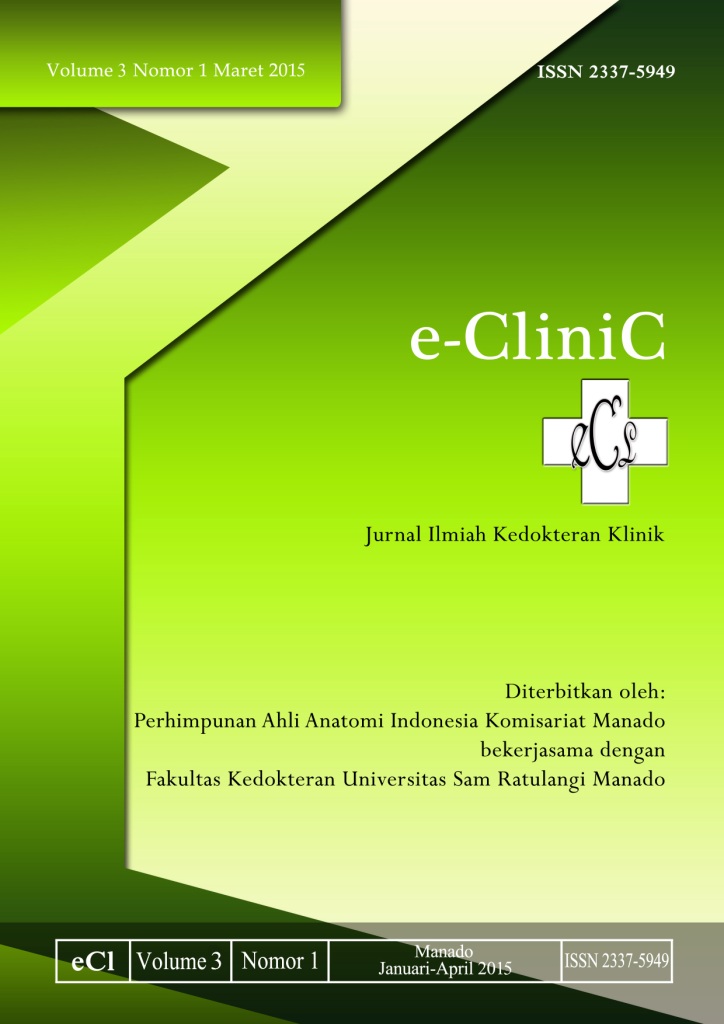PROFIL LIPID PADA PASIEN DENGAN PENYAKIT JANTUNG KORONER DI BLU RSUP PROF. DR. R. D. KANDOU TAHUN 2012
DOI:
https://doi.org/10.35790/ecl.v3i1.7480Abstract
Abstract: Diabetes mellitus (DM) is a health problem that increases the number of events globally. Medical doctor as the first line in the treatment of diabetes are required to have good knowledge about its management. Students of the Faculty of Medicine, University of Sam Ratulangi trained to become medical doctor were had good knowledge about management of diabetes melitus. The problem is what is the description of knowledge about DM management on undergraduate students and professional education programs of medical doctor (P3D) students. This study aimed to compare the level of knowledge about DM management among undergraduate students and P3D students of Faculty of Medicine, University of Sam Ratulangi. This was a descriptive analytical study with a quantitative approach involving 80 subjects were selected based consecutive sampling and was answered the questionnaire about knowledge of DM management. Results: The subjects knowledge about DM management in undergraduate students from 40 subject result 1 subject (2.5%) are included in the category of good knowledge, 7 subject (17.5%) had moderate knowledge and 32 subjects (80%) are included of low knowledge. From the P3D students, 3 subjects (7.5%) with good knowledge category, 25 subjects (62.5%) with moderate knowledge and 12 subjects (30%) with low knowledge category. Conclusion: Knowledge level about DM management among undergraduate students was still low. P3D student knowledge level about diabetes management was classified as moderate. Knowledge level about diabetes management among P3D students was better than undergraduate students.
Keywords: Knowledge, medical students, management of diabetes mellitus
Abstrak: Penyakit Jantung Koroner merupakan salah satu bentuk dari penyakit kardiovaskuler (penyakit jantung dan pembuluh darah) yang menjadi penyebab kematian nomor satu di dunia. Penyebab PJK secara pasti belum diketahui, meskipun demikian secara umum dikenal berbagai faktor yang berperan penting terhadap timbulnya PJK yang disebut sebagai faktor risiko PJK seperti Dislipidemia , Hipertensi , dan obesitas. Penelitian ini bertujuan untuk Mencari tahu Peran penting Peningkatan profil Lipid pada pasien Penyakit Jantung Koroner di BLU RSUP Prof Kandou tahun 2012. Penelitian yang digunakan adalah penelitian yang bersifat deskriptif dan dilaksanakan dengan cara mengambil / mengumpulkan data sekunder rekam medis sebanyak 32 sampel di Bagian Ilmu Penyakit Dalam sub.bagian kardiovaskuler RSUP Prof. DR. R. D. Kandou Manado. Dari 32 sampel pasien Penyakit jantung koroner Manado81%(26 orang) dengan kolestrol total yang di inginkan , 91%(29 orang) dengan LDL rendah , 69%(22 orang) dengan trigliserida yang di inginkan , dan 47%(16 orang) dengan LDL batas normal tertinggi. Simpulan: Profil lipid sangat berperan penting dalam proses terjadinya penyakit jantung koroner terutama pada peningkatan LDL dan penurunan HDL
Kata kunci: pengetahuan, mahasiswa kedokteran, manajemen diabetes mellitus
Downloads
How to Cite
Issue
Section
License
COPYRIGHT
Authors who publish with this journal agree to the following terms:
Authors hold their copyright and grant this journal the privilege of first publication, with the work simultaneously licensed under a Creative Commons Attribution License that permits others to impart the work with an acknowledgment of the work's origin and initial publication by this journal.
Authors can enter into separate or additional contractual arrangements for the non-exclusive distribution of the journal's published version of the work (for example, post it to an institutional repository or publish it in a book), with an acknowledgment of its underlying publication in this journal.
Authors are permitted and encouraged to post their work online (for example, in institutional repositories or on their website) as it can lead to productive exchanges, as well as earlier and greater citation of the published work (See The Effect of Open Access).







